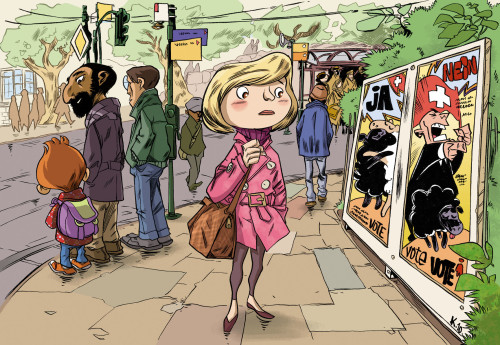The baloti.ch project shows the difficulties in engaging the disenfranchised in the political process using e-participation apps
Can a society be peaceful, prosperous, and happy when 25% of the population lack political rights on the national level? Uwe Serdült thinks not, and helped build an app to provide informal voting rights using an e-participation app for use in Swiss referendums. Although the app wasn’t a resounding success, it did provide an opportunity for disenfranchised people to participate in the national political process for the first time.
In Switzerland almost 25% of the resident population doesn’t have political rights on the national level. Cantons are, however, free to decide whether they want to introduce active or passive voting rights for cantonal or communal matters. Some have already done so and introduced voting rights for foreigners on the communal level under certain conditions (Fribourg 2006, Geneva 2005, Jura 1979, Neuchâtel 1849, Vaud 2003). The cantons of Jura (1979, ten years residence in Switzerland, one year in Jura) and Neuchâtel (2001, five years residence in the canton) have even extended active voting rights for foreign residents on to the cantonal level. Others have taken a more cautious approach and only granted their communes the option to introduce voting rights for foreigners, such as Appenzell Ausserrhoden (1995, till now in the communes of Wald, Speicher and Trogen), Graubünden (2003, 22 communes have introduced it so far, all of them smaller ones), and Basel-Stadt (2005, none so far).
In Switzerland, not granting suffrage to a large portion of the resident population ends up creating even more problems, because there are referendum votes on all state levels very frequently. As much as I am personally in favour of direct democratic mechanisms in a general sense, one could also look at them from a different angle. Three or four times a year, all foreigners living in Switzerland are reminded of the fact that they have no say in politics. This may cause a number of politically interested foreign residents to become detached from politics all together.
The question is thus whether a society with a large proportion of residents without political rights can be peaceful, successful and just in the long term? I do not personally think so. Furthermore, it risks creating a worrying situation which could potentially lead to major conflicts, for example during a longer period of economic recession.
 I therefore submitted a bid for funding for an applied research project, which aimed at giving political rights to people living in Switzerland without suffrage via an online platform, and got it financed by the Federal Office of Migration, and to a smaller degree also by the Federal Office of Communication. The website was called baloti which means ‘to vote’ or ‘to elect’ in Esperanto. baloti.ch was also an attempt to give migrants in Switzerland the opportunity to become familiar with the Swiss political system in a practical way, because many of them will one day – after twelve years of residence – apply for citizenship.
I therefore submitted a bid for funding for an applied research project, which aimed at giving political rights to people living in Switzerland without suffrage via an online platform, and got it financed by the Federal Office of Migration, and to a smaller degree also by the Federal Office of Communication. The website was called baloti which means ‘to vote’ or ‘to elect’ in Esperanto. baloti.ch was also an attempt to give migrants in Switzerland the opportunity to become familiar with the Swiss political system in a practical way, because many of them will one day – after twelve years of residence – apply for citizenship.
During a two-year pilot phase, direct democracy could be exercised in eleven languages on the baloti platform (which is, at the time of writing, not online) parallel to the actual national referendums. In this way, the platform enabled migrants access and participation to one of the key elements of the Swiss political system. The online platform was open to all and could also be used by Swiss citizens or for educational purposes.
So how did the platform work? The information provided on each referendum on baloti.ch was translated into the eleven languages most spoken in Switzerland: German, French, Italian, English, Spanish, Portuguese, Turkish, Albanian, Serbian, Croatian and Tamil. To keep efforts within reasonable limits the texts on the platform were kept short. The vocabulary corresponded approximately to a lower secondary school level. Data collection and analysis were anonymous. Personal data was not saved long-term or used for any reason other than statistical analysis. Participants were informed of this in a disclaimer on the website and also during the voting process. To keep the obstacles to participation as low as possible users were not required to register to vote but only needed a valid email address in order to receive the encryption key for voting. The project was interdisciplinary and comprised of IT personnel as well as staff with language and social science expertise.
Once the technical side of the voting system could be considered secure, the primary goal was to advertise the platform. We undertook great efforts to do this, however, we also realised that ‘continuous advertising’ would be too much of a burden for our team, and, in any event, would not automatically result in more visitors to the website. For diffusion we made use of the following channels: TV and radio, printed and online press, direct email campaigns, multiplier organisations, Facebook and Twitter campaigns as well as Google ads.
Figure 1: Number of visitors to baloti.ch according to Google Analytics
From the visitor statistics (Fig. 1) it becomes evident that, despite increased marketing efforts including Facebook campaigns at the end of the pilot phase, the interest in baloti.ch decreased steadily over time. At the beginning of the project there was a national television broadcast about baloti.ch during prime time news. The impact of coverage in the Swiss national television evening news bulletin on 21 September 2010 was clearly evident in the visitor statistics obtained from Google Analytics. That level could unfortunately not be maintained in the long run. However, on the positive side, it can be said that the platform attracted visitors from all regions and migrant languages spoken in Switzerland. Overall we had roughly 13’000 unique visitors, in all the languages, from all parts of the country. However, only 1’300 people actually cast a valid vote.
The main goal of baloti.ch was to have those people who visited the website casting a vote. We therefore defined indicators allowing us to understand user behaviour and to evaluate to what extent we achieved our goals. Of those people who requested a voting code, 69.3% actually voted. The request for a voting code is thus a good indicator for the voting intention of the visitor. Also clearly apparent were the problems that arose during the voting process on the occasion of the referendums in 2010, and in particular for the one in November 2010 with three ballot questions. Feedback from users and our own evaluation of this second referendum we covered on baloti.ch hinted at difficulties with the voting process and eventually our web design. A relatively large proportion of potential voters got lost in the process. Various modifications were then made in order to correct for these problems with the consequence that performance improved again.
A second indicator was the number of people who voted on baloti.ch repeatedly (see Tab. 1). 910 people voted at least once; 27.2% of those voted twice or more often. If we assign a voting index between 1 and 4 with which to determine the average number of votes per person, the index for baloti is 1.4. This low value makes an analysis of the reasons for the weak commitment of visitors to the baloti website necessary. Particularly, what needs to be studied is to what extent the weak commitment was caused by usability issues (user ignorance or difficulties with the application of the website) or due to other reasons (lack of diffusion or interest, distrust, etc.). This research was not able to be carried out during the pilot. We surmise, however, that the weak commitment relates to the short-lived attention span for e-participation platforms in general and the purely symbolic nature of the vote.
Table 1: Percent of repeated voting on baloti.ch across the four votes
| Participating | Number of Voters | % Voters |
| once | 663 | 72.9 |
| twice | 170 | 18.7 |
| three times | 58 | 6.4 |
| four times | 19 | 2.1 |
| Total | 910 |
With the exception of two votes, the results from baloti.ch referendums never corresponded to the official Swiss results. We attributed this outcome to the small number of votes cast on baloti.ch and the fact that the website primarily seemed to attract votes from politically left-oriented circles. Our hypothesis, that with higher figures the baloti.ch result would have become comparable to the voting result of Swiss citizens, could unfortunately not be tested due to the low number of voters.
Summing up, we had to learn that e-participation projects are cruel. Success and failure are each directly measurable. In the quantitative sense the overall result of this experiment might therefore not seem to be encouraging, however, I think there is an obligation to report and document what happened nevertheless. And sometimes one needs to hang in there, adapt the setup, and give it another try.
—
Note: this post is based on the following paper: Serdült, Uwe (2015) baloti.ch: A Multi-Lingual e-Participation Platform for Swiss Migrants, in: Parycek, Peter and Edelmann, Noella (Eds.) CeDEM15 Conference for E-Democracy and Open Government 2015, 20-22 May 2015, Danube University Krems, Austria, 299-304. It represents the views of the author and not those of Democratic Audit UK or the LSE. Please read our comments policy before posting.
—
 Uwe Serdült is a senior researcher and lecturer working for the ‘Center for Democracy Studies Aarau’ (ZDA) at the University of Zurich, Switzerland. His research focuses on political participation, referendums and internet voting (https://uweserdult.wordpress.com).
Uwe Serdült is a senior researcher and lecturer working for the ‘Center for Democracy Studies Aarau’ (ZDA) at the University of Zurich, Switzerland. His research focuses on political participation, referendums and internet voting (https://uweserdult.wordpress.com).
![]() This post was based on a presentation given by the author at the 2015 CeDem conference in Krems, Austria
This post was based on a presentation given by the author at the 2015 CeDem conference in Krems, Austria







 Democratic Audit's core funding is provided by the Joseph Rowntree Charitable Trust. Additional funding is provided by the London School of Economics.
Democratic Audit's core funding is provided by the Joseph Rowntree Charitable Trust. Additional funding is provided by the London School of Economics.
The baloti.ch project shows the difficulties in engaging the disenfranchised in the political process using apps: https://t.co/HXNhxbP0QG
[…] Biomagnetism. IBM Watson Analatics. CONSOLIDATED LIST OF FINANCIAL SANCTIONS TARGETS IN THE UK. Newspapers in United Kingdom. Today's press covers. Kiosko.net. The baloti.ch project shows the difficulties in engaging the disenfranchised in the political proces…. […]
The baloti.ch project shows the difficulties in engaging the disenfranchised in the political process using apps https://t.co/RprjNpjIG7
The baloti.ch project shows the difficulties in engaging the disenfranchised in the political process using e-part… https://t.co/TxveuVQt7j
The baloti.ch project shows the difficulties in engaging the disenfranchised in the political process using e-… https://t.co/mf5dLFBx8r
Difficulties for #eparticipation apps in engaging disenfranchised; but still a fascinating project! https://t.co/DDtyfVSUIR @democraticaudit
The Swiss baloti project shows that it’s hard to get uninvolved citizens using e-participation apps https://t.co/Yr2IsktX3j
The baloti.ch project shows the difficulties in engaging the disenfranchised in the… https://t.co/JkHqHESujw https://t.co/i6d1eOgj5H
Hi there everyone, it’s my first pay a quick visit at this web site,
and piece of writing is really fruitful in favor of me, keep up posting these posts.